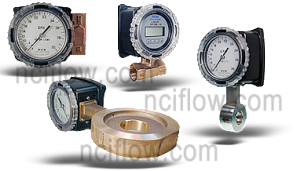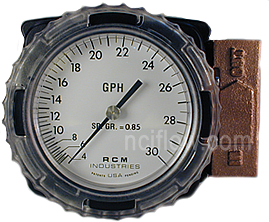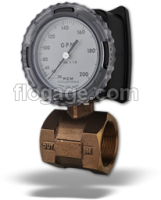RCM Liquid Flow Meters
RCM Series 7000 and RCM Series 8000

RCM liquid flow meters have been developed for industrial applications where durability and reliability are important considerations in the monitoring of flow. The Flo-Gage has accuracy for most industrial processes and is particularly suited for applications where compactness, low cost, minimal maintenance and resistance to accidental damage are important factors.
RCM liquid flow meters are suitable for potable and non-potable water, irrigation water, glycol-water mixtures, fuel oils, lubricating oils, gasoline and many other low and medium viscosity liquids (maximum viscosity 500 centipoise).
- Meters are available in Bronze, Monel or 316SS.
- Threaded Connections (Series 7000) from 1/4″ to 3″ in NPT or BSP.
- Wafer Style (Series 8000) from 1/2″ to 8″.
Option: Flow Meter Configured Specifically for Liquid Ammonia Service
Liquid ammonia is used in industrial cooling systems, fertilizer and NOx emissions. Liquid ammonia service flow meters are constructed of stainless steel with EPR seals and a gasketed case. The flow meter has been developed for industrial applications where durability and reliability are important considerations in the monitoring of Liquid ammonia flow.
 Standard Features:
Standard Features:
- Sturdy in-line metal construction to withstand piping stresses without breaking.
- Black on white dial won’t crack, glaze or become hard to read with age.
- Expanded 3.5″ (90mm) 270° analog dial for reading at a glance.
- Suitable for use with both opaque and clear fluids.
- Measures 6:1 range with 3% F.S. Accuracy.
- Dial and case factory configured for quick installation – but easily field re-configured if needed.
- Liquid flow ranges from 4 GPH (15 l/h) in 1/2″ meter to 3000 GPM (1200 l/m) in 8″ meter.
Selecting Meters for Liquid Service
- The Flo-Gage can be used to meter flow rates of a wide variety of liquids including water, fuel oils (#2 through #6), lubricants, solvents and many chemical compounds.
- For best accuracy, select a flow rate which will permit normal operation in the upper half of the meter scale.
- To choose the proper meter, select pipe size and full scale flow rate from the chart of “Standard Flow Rates and Body Sizes“.
 Minimum Flow Rates:
Minimum Flow Rates:
The minimum flow rate which can be read is approximately 15% of the full scale flow rate for all meters. For best accuracy, select a flow rate which will permit normal operation in the upper half of the meter scale.
lnstallation Guidelines:
Provide 10 diameters of straight pipe in front of meter. Install control valves or solenoid valves downstream of meter if possible.
Services Not Recommended:
Flo-Gages are not recommended for the following kinds of service:
- Resins, paints or monomers which can form solid deposits in the piping system.
- “Super-solvents” which attack most available elastomers.
- Sulfuric acid in any concentration.
- Foams which tend to have inconsistent densities.
- Toxic substances requiring hermetically sealed enclosures.
- Fluids with viscosity above 500 centipoise.
- Pumping systems using piston pumps which produce non-steady flow conditions.
- Gravity-fed systems having less head than the pressure loss across the meter at normal operating conditions.
| Specifications | Standard | Optional |
|---|---|---|
| Series 7000 | FNPT (threaded) Standard | |
| Series 8000 | Wafer unit mount between 150 or 300 class flanges. | |
| Housing | UV Stabilized Polycarbonate | Aluminum |
| Body | Bronze | Monel / 316SS |
| Bellows | Bronze | Monel / 316SS / Inconel |
| Seals | Buna N | Viton / EPR / Teflon |
| Crystal | Polycarbonate | Glass |
| Gear Movement | Bronze | 316SS |
| Accuracy | u00b1 3% F.S. | u00b1 3% F.S. |
| Repeatability | u00b1 1% F.S. | u00b1 1% F.S. |
| Maximum Pressure | 180 psig (12.6 kg/cm2) | 400 psig (28.1 kg/cm2) |
| Minimum Pressure | 10 psig (0.67kg/cm2) | 10 psig (0.67kg/cm2) |
| Maximum Temperature | 212 F (100 C) | 350 F (177 C) |
| Minimum Temperature | -30 F (-34 C) | -80 F (-62 C) |
